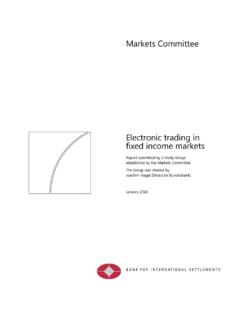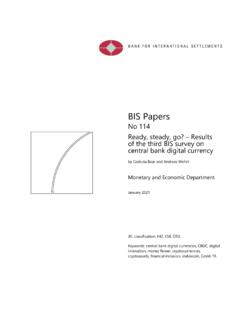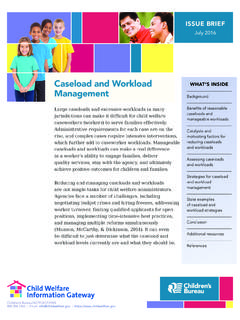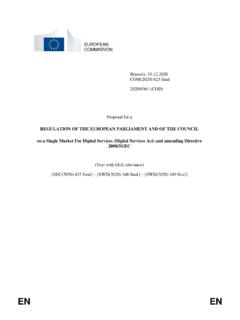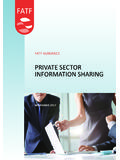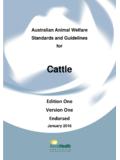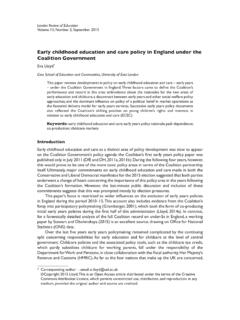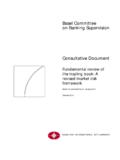Transcription of Committee on Payments and Market Infrastructures
1 Committee on Payments and Market Infrastructures Correspondent banking July 2016 This publication is available on the BIS website ( ). Bank for International Settlements 2016. All rights reserved. Brief excerpts may be reproduced or translated provided the source is stated. ISBN 978-92-9197-616-4 (print) ISBN 978-92-9197-617-1 (online) CPMI - Correspondent banking July 2016 Contents Executive summary .. 1 1. Introduction .. 6 2. Developments in correspondent banking .. 9 Concept of correspondent banking .. 9 Recent developments in correspondent banking qualitative analysis .. 11 SWIFT data analysis quantitative analysis .. 13 Data description .. 13 Results .. 14 3. Potential measures to facilitate correspondent banking services .. 18 General considerations .. 18 KYC utilities .. 19 Legal Entity Identifier (LEI) .. 23 General information on the LEI .. 23 LEI and correspondent banking.
2 24 Information-sharing .. 27 Payment messages .. 32 General considerations .. 32 Message flows .. 33 Usage of the LEI as additional information in payment messages .. 38 4. Conclusions .. 39 Annex 1 References .. 41 Annex 2 43 Annex 3 SWIFT data analysis .. 47 Annex 4 Members of the CPMI Working Group on Correspondent Banking .. 58 Abbreviations AML/CFT Anti-Money Laundering and Countering the Financing of Terrorism AMLEG BCBS AML/CFT Expert Group BCBS Basel Committee on Banking Supervision BIC Business Identifier Code CBCG FSB Correspondent Banking Coordination Group CLS CPMI Continuous Linked Settlement Committee on Payments and Market Infrastructures ECB European Central Bank ECC BIS Economic Consultative Committee FATF Financial Action Task Force FMI Financial Market Infrastructure FSB Financial Stability Board GLEIF Global LEI Foundation GPFI Global Partnership for Financial Inclusion G-SIBs Global Systemically Important Banks ISAE International Standard on Assurance Engagements ISO International Organization for Standardization KYC Know-your-customer LEI Legal Entity Identifier LEI ROC LOU Legal Entity Identifier Regulatory Oversight Committee Local Operating Unit (for the issuance and management of LEIs)
3 OFAC Office of Foreign Assets Control PMPG Payments Market Practice Group SME Small and Medium-sized Enterprise SWIFT Society for Worldwide Interbank Financial Telecommunication CPMI - Correspondent banking July 2016 1 Executive summary Through correspondent banking relationships, banks can access financial services in different jurisdictions and provide cross-border payment services to their customers, supporting international trade and financial inclusion. In view of the importance of correspondent banking, the keen interest of central banks in this activity and any threats to its safe and efficient functioning, the Governors of the BIS Economic Consultative Committee (ECC) have mandated the CPMI to produce a report on this issue. In response, the CPMI Working Group on Correspondent Banking has prepared this technical report describing current trends and analysing measures that might alleviate some of the concerns and cost issues related to correspondent banking.
4 Banks have traditionally maintained broad networks of correspondent banking relationships, but there are growing indications that this situation might be changing. In particular, some banks providing these services are reducing the number of relationships they maintain and are establishing few new ones. The impact of this trend is uneven across jurisdictions and banks. As a result, some respondent banks are likely to maintain relationships, whereas others might risk being cut off from international payment networks. This implies a threat that cross-border payment networks might fragment and that the range of available options for these transactions could narrow. In addition, an analysis using SWIFT data shows that there seems to be a trend towards concentration in correspondent banking activities. Rising costs and uncertainty about how far customer due diligence should go in order to ensure regulatory compliance (ie to what extent banks need to know their customers customers the so-called KYCC) are cited by banks as among the main reasons for cutting back their correspondent relationships.
5 To avoid penalties and related reputational damage, correspondent banks have developed an increased sensitivity to the risks associated with correspondent banking. As a consequence, they have cut back services for respondent banks that (i) do not generate sufficient volumes to overcome compliance costs; (ii) are located in jurisdictions perceived as too risky; (iii) provide payment services to customers about which the necessary information for an adequate risk assessment is not available; or (iv) offer products or services or have customers that pose a higher risk for anti-money laundering/combating the financing of terrorism (AML/CFT) and are therefore more difficult to manage. The regulatory framework is taken as given in this report, as are in particular the AML/CFT requirements and the related implementing legislation and regulations in different jurisdictions . It is acknowledged that these requirements, as agreed by the competent authorities, along with strict implementation, are necessary to prevent and detect criminal activities and ensure a healthy financial system.
6 The working group limited its analysis to measures that could help improve the efficiency of procedures, reduce compliance costs and help address perceived uncertainty, without altering the applicable rules and the basic channels for correspondent banking services between correspondent and respondent banks. The group analysed in detail some potential measures and translated them into five recommendations. An earlier version of this report was issued for consultation in October 2015. This final version of the report has been revised in the light of public comments received during the consultation, which are published on the BIS website1, and further interactions with relevant stakeholders. The major changes in this final report relative to the consultative report include the following: 1 2 CPMI - Correspondent banking July 2016 (i) Recommendation on the use of know your customer (KYC) utilities Many of the comments pointed out that there is currently no standardisation in the type and format of information in different KYC utilities and that such inconsistencies in the gathering of information limit the value of KYC utilities.
7 Therefore, the CPMI has decided to enhance the previous recommendation by inviting relevant standard setters such as the International Organization for Standardization (ISO) to consider defining a standardised minimum set of information and data (including the format) that all utilities should collect and that all banks have to be ready to provide to other banks which require the information and data. In addition, many of the comments argued that, for KYC utilities to be more effective, in addition to standardising the data and formats, it would be necessary that banks have some assurances from relevant authorities (such as the regulatory, supervisory or law-enforcement authorities) with respect to the appropriateness of and reliance upon any such utility for the purposes of AML/CFT compliance. Therefore, the authorities with responsibility for AML/CFT (ie the Financial Action Task Force (FATF) and the Basel Committee on Banking Supervision AML/CFT Expert Group (AMLEG)) are invited to consider developing a set of issues that financial institutions should consider when using KYC utilities, to support an appropriate use of these utilities.
8 (ii) Recommendation on the use of the Legal Entity Identifier (LEI) in correspondent banking All authorities and relevant stakeholders are invited to consider promoting BIC-to-LEI mapping facilities, which allow for an easy mapping of routing information available in the payment message to the relevant LEI. In addition, relevant authorities (eg the LEI Regulatory Oversight Committee (LEI ROC) and AMLEG) are encouraged to elaborate further as to what extent banks can rely on the LEI as a means of accessing reliable information to support customer due diligence in correspondent banking. (iii) Recommendation on information-sharing initiatives Many of the comments sought a further clarification on data privacy concerns in the area of correspondent banking and highlighted the potential conflicts between the sharing of relevant information across jurisdictions and existing national data privacy regulations. Therefore, the FATF and AMLEG are invited to further explore ways to tackle obstacles to information-sharing, with the aim of identifying potential best practices (in the enterprise-wide context, among financial institutions not part of the same financial group, and between the public and the private sector).
9 (iv) Recommendation on payment messages The majority of the comments validated the argument that both methods (ie the serial MT 103 method and the cover MT 202 COV method) can be used in full compliance with AML/CFT as well as relevant regulatory requirements when all data fields are accurately populated in a payment message. Therefore, the CPMI decided to modify the initial recommendation and leave the decision to individual banks as to which method should be used. Given the importance of ensuring the transparency and accuracy of information in payment messages, the CPMI has decided to invite the relevant stakeholders (ie the Wolfsberg Group and the Payments Market Practice Group (PMPG)) to review their principles governing the use-cases for payment messages, what information should be included and which data fields should be used. In addition, the AMLEG is invited to consider developing further guidance on supervisors role in ensuring that banks meet FATF Recommendations and guidance on the quality of payment message content.
10 CPMI - Correspondent banking July 2016 3 (v) Recommendation on the use of the LEI as additional information in payment messages Before the use of LEIs becomes widespread or even compulsory for banks and corporate customers, relevant stakeholders could start analysing how the LEI might be used on an optional basis in a more structured way within the current relevant MT messages (ie MT 103 and MT 202 COV). Therefore, relevant stakeholders (eg the PMPG) should work to define a common Market practice for how to include the LEI in the current relevant payment messages without changing the current message structure. Also, as part of a potential future migration to message formats based on the ISO 20022 standard, relevant stakeholders (ie ISO and SWIFT) are encouraged to consider developing dedicated codes or data items for the inclusion of the LEI in these payment messages. The CPMI believes that its recommendations might alleviate some of the costs and concerns connected with correspondent banking activities.










